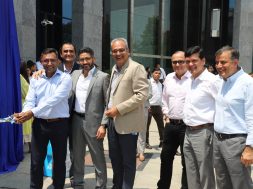The growth of India’s IT sector has brought about many positive changes in the Indian economy. Shrinivas Rao, CEO-Asia Pacific, Vestian Global Workplace Services evaluates the need of raising bar in safety & security standards of Indian IT Parks
Over the past two decades, Information Technology has become one of the fastest growing industries in India. High demand, liberalised policies, availability of skilled manpower, cost benefits and various other factors have placed India amongst the fastest growing IT markets in the Asia Pacific region. These factors jointly have also helped in evolution of a brand new concept in the infrastructural design and construction of IT office campuses/Technology Parks in India.
Recently, The Royal Institution of Chartered Surveyors (RICS) and Vestian Global Workplace Services released a PAN India report titled ’Assessment of IT campus environments’. The study has been instrumental in evaluating the working environment of IT campuses in the country. It also underlines the changing dynamics of a typical workplace atmosphere and will benefit the overall operational performance.
The broad objective of this study was focused on evaluating existing IT Campuses with regard to several parameters such as basic amenities, planning highlights, safety & security, operations & maintenance (O&M) and innovation. Further emphasis was laid on recognising the key preferences of tenants and investigating the overall effect this had on the performance of the workplace. Fifteen renowned IT/ITES campuses across India willingly participated in this first of a kind initiative, and data was collected across 250-plus points.
While conducting the study some interesting trends were identified such as:• Integrated townships / mixed developments have 10-20 per cent higher economic value than single use developments • IT campuses which provide a minimum of at least 4 basic amenities can command a rent premium of 18.5 per cent as compared to IT campuses with no amenities• Safety & security is the most influential parameter having an impact of 35 per cent on the holistic performance of IT campuses• Innovation is the second most differentiating parameter and has an impact of 30 per cent on the overall performance of IT campuses• Developers are increasingly opting for green certification for their parks. However, a green certified building commands only 1.9 per cent higher rent premium as compared to a non-certified building• 70 per cent of the occupiers have rated availability of amenities, ease of accessibility, rent, safety aspects and grade of the building as crucial factors for site selection; whereas, only 40 per cent of occupiers rated environment friendly initiatives as important factor in site selection process• Gaps between intentions of National Building Code (NBC) guidelines and state legislation towards fire safety norms have been established.
With every unit increase in planning highlight, the rent premium is expected to increase by 4.38 per cent. The study reveals most of the IT Parks were well equipped in terms of basic amenities. However, Operations and Maintenance in most parks was not up to the mark and required constant attention from the authorities.
Apart from this, there were some other areas of improvement that were identified while scrutinising the arrangements of the Tech parks to emergency situations such as the preparedness to combat terror threat, disaster management, etc.
Preparedness to combat terror threatIt is observed that limited effort is being made towards safeguarding our campuses from terror threat. The most valuable asset in these parks is work force; hence installation of expensive terror combating features does necessarily add economic value to the IT Park. But this too would incur additional expenditure and thus is an area that most developers choose to neglect.
Disaster ManagementWe should take a lesson from Japan’s latest earthquake and tsunami disaster- and invest both time and money to cope with disaster management. Currently, availability of Safety Plan & Training programs (to implement safety plan) is not the strength of the industry. Most campuses fail to conduct fire drills at regular intervals, although these are measures specifically prescribed by the NBC, 2005 guidelines. The Carlton Towers experience can be considered as a classic example on how all hell breaks loose during a fire, and even the most reasonable and intelligent professionals become clueless on basic safety measures. Additionally, certain systems can be incorporated into the system that would help during times of hazard.
The use of centrifugal jet fans in the basement to remove smoke and excess carbon monoxide can help to maintain high visibility levels and also reduce chances of suffocation during a fire. Another arrangement necessary to prevent the spread of fire and smoke is the installation of automatic detection and alarm system in AC ducts. The inclusion of pressurised staircases, sprinkler systems, and fire lifts that are connected to an alternate power source are pre-requisites to ensuring complete safety and security in the tech parks.
3rd Party Vendor for FM ServicesAnother observation is that most of the developers rely on in-house or hybrid model for FM services; only 20 per cent of the participating parks rely on 3rd party vendors for FM operations. This usually results in a dip in the professionalism of the system. In most instances, essential logs are not maintained, systems are not upgraded. All this affects the overall functionality of the tech park in question and hence it is always advisable to employ external / 3rd party vendors and conduct quality check at regular intervals.  Accommodation of Physically Challenged people needs in building designThe building design across the IT campuses is not 100 per cent compliant to “The Persons with Disabilities Act, 1995”. Aspects such as dedicated parking space for physically challenged people, lifts supporting their requirements, antiskid material on floor etc have been found somewhat lacking. These are small aspects, and do not incur large costs, yet most developers have not paid any regard to including in the design of the tech parks. These key facilities are instrumental in raising the bar of the IT campuses to global standards.
IT Campus specific building design requirementsBuilding infrastructure and services for IT campuses are designed on the basis of occupancy load of 1 person every 100 sq ft (recommendation by NBC), but it has been observed that especially for ITES/ BPO functions space requirement is around 60 -70 sq ft/person. This occupancy load difference tends to increase pressure on the building infrastructure and services.
FY-2012 is a landmark year – while the Indian IT industry has been anticipated to weather uncertainties in the global business environment, this is also the year when the industry has been projected to achieve significant growth. Industry experts expect the aggregate revenue for FY-2012 to cross USD 100 billion and set milestone. Hence, with such boom in the industry, it is necessary to acknowledge the efforts of the human quotient that make up the IT industry and cater suitably to their needs.
Going forward, we need to lay emphasis on certain aspects such as green certification, post occupancy evaluation, facility management, etc to upscale our IT parks to global standards.
Attention to raising Green awareness could help to raise the credibility of the tech park. The most common agent used for fire-fighting is halon-based sprinkler systems that can be substituted with water mist or inert gas. Another component to avoid could be the use of CFC free and zero ODP materials is prevalent in refrigeration, air-conditioning and electrical panels.
Further improvisation of social & business infrastructure in IT campuses and rise in percentage of development of integrated IT developments/townships will help leverage our tech parks to global standards. Additionally it will generate credibility and revenue making India a suitable choice to its south-east Asian competitors. Also, enhancing the efficiency in building operations and systems can be achieved by means of increased collaboration between developers and occupiers. Additional strategies would be:• Rise in adoption of Specialised/ 3rd Party FM service providers• Adopt sustainable transport infrastructure and systems (MRTS, buses, etc)• Conduct Post Occupancy Evaluation (POE) to improvise space utilisation, communication between occupiers and developers, building services and others.
To sum up, the growth of India's IT sector has brought about many other positive changes in the Indian economy. It is up to the policy makers, the developers and the tenants to jointly acknowledge this growth, and conduct forums to discuss the challenges faced, and arrive at suitable solutions. Policy makers must aid the developers with certain allowances; it is only then that the developers will go the extra mile to ensure innovative solutions in the infrastructure and design of the IT parks. Moreover, tenants must also be sensitive to the efforts of the developers and the needs of their employees. A basic understanding should be achieved between the developer, tenant and government to ensure progressive development in the IT and ITes industry in India.
Cookie Consent
We use cookies to personalize your experience. By continuing to visit this website you agree to our Terms & Conditions, Privacy Policy and Cookie Policy.









